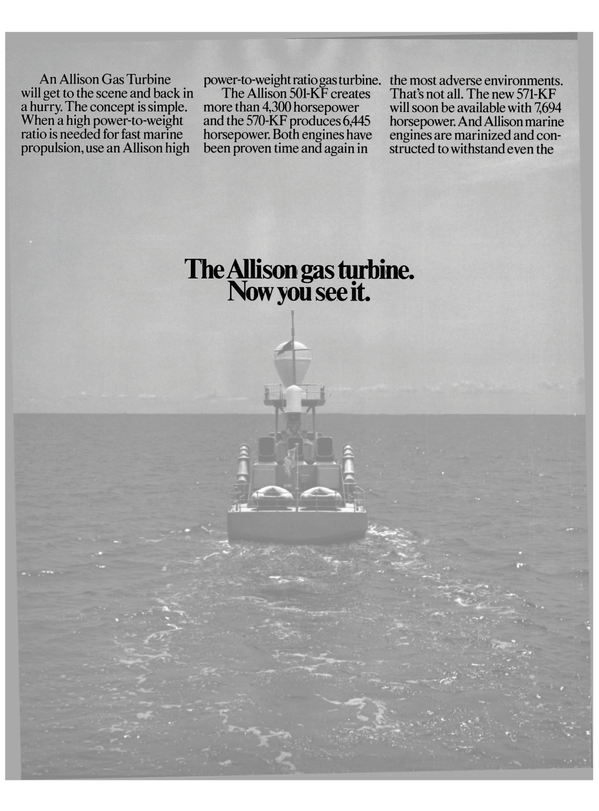
Ingalls Shipbuilding Christens Another Aegis Missile Cruiser
The first U.S. Navy surface warship to be named in commemoration of the Civil War Battle of Mobile Bay in Alabama was christened at the Ingalls Shipbuilding division of Litton Industries in Pascagoula, Miss., recently.
The ship, officially named Mobile Bay (CG-53), is the sixth of 12 Aegis guided-missile cruisers contracted to Ingalls by the Navy. Principal speaker for the ceremony, held at the company's West Bank yard, was Alabama Senator Jeremiah A.
Denton Jr., a native of Mobile.
Mrs. Denton served as the ship's sponsor and broke the traditional bottle of champagne across the cruiser's bow.
The Mobile Bay is the second U.S. warship to be equipped with the MK 41 Vertical Launching System (VLS), a multiwarfare missilelaunching system capable of firing a mix of missiles against airborne, surface, and underwater targets. It is modular in design, with modules symetrically grouped to form launcher magazines, located both fore and aft on the ship's deck.
Each module contains all the necessary components for launching functions when interfaced with the Mobile Bay's Aegis weapons system.
Each of the magazines will fire a mix of antiair, antiship, and antisubmarine missiles, greatly extending the ship's missile flexibility.
Other participants in the ceremony included Vice Adm. Joseph Metcalf III, Deputy Chief of Naval Operations, Surface Warfare; Commo. John F. Shaw, USN, Aegis Shipbuilding Program Manager; Jerry St. Pe, vice president of Litton and president of Ingalls Shipbuilding division; and Capt.
George W. Dowell III, USN, Su pervisor of Shipbuilding, Pascagoula.
The Most Reverend Oscar H.
Lipscomb, Archbishop of Mobile, delivered the invocation.
Aegis ships comprise the most important shipbuilding program in the U.S. today. The Mobile Bay and other ships of the Aegis class will provide the primary protection for the navy's battle forces well into the next century. The Aegis ships are designed to counter all present and projected threats to the Navy's forces.
The ship's Aegis weapons system, the heart of her fighting capability, is a significant advance in fleet air defense. Four fixed-array radar antennae, mounted on the four sides of the ship's superstructure, replace conventional rotating radars, enabling the ship's crew to "see" in all directions simultaneously.
The Aegis weapons control system can simultaneously direct and fire more missiles at more targets, with greater accuracy, than any other system.
Aegis cruisers are large ships— 567 feet long with a beam of 55 feet.
Four 20,000-shp gas turbine engines power the 9,400-ton ships to speeds in excess of 30 knots.
Ingalls Shipbuilding, lead shipbuilder for five of the latest classes of Navy surface combatants, has delivered 43 major warships into the Navy's fleets since 1975, a majority of the surface combatants delivered during the period. As lead yard for the Aegis Program, Ingalls has been contracted to build 12 of the 16 Aegis cruisers authorized since 1978.
The lead ship, USS Ticonderoga (CG-47), was deliverd to the Navy ahead of schedule in January 1983, and has begun a second deployment with the Navy's Sixth Fleet. The second ship of the class, the USS Yorktown (CG-48), was commissioned in July 1984 and has begun her first Atlantic Fleet deployment.
The Navy's third Aegis cruiser, the USS Vincennes (CG-49), was commissioned into the Pacific Fleet in July this vear, and a fourth ship, the Valley Forge (CG-50), will join the Pacific Fleet in January 1986.
Ingall's fifth cruiser, the Bunker Hill (CG-52), is in the outfitting phase.
Read Ingalls Shipbuilding Christens Another Aegis Missile Cruiser in Pdf, Flash or Html5 edition of November 1985 Maritime Reporter
Other stories from November 1985 issue
Content
- BPNAP Marine Lubricants Relocates In N e w Jersey page: 5
- Clemlite® System Offers Economy And Safety page: 5
- Fifth Maritime Prepositioning Ship Delivered By Bethlehem-Beaumont page: 6
- Versatile Vickers Awarded Refit Contracts Worth $15 Million From Canadian Navy page: 6
- Todd-Seattle A w a r d ed $ 6 - M i l l i o n N a v y Contract For Work On Support Ship page: 7
- Oceaneering Uses Signals From GPS Satellites To Position Drilling Rig page: 7
- Newman's Offers N ew Brochure On Complete Line Of Ball Valves page: 8
- Royal Navy Purchases Raytheon Bathy System page: 8
- Africa Ocean Lines Getting First N e w Containerships From East German Shipyard page: 9
- Waller Heads N e w Firm Based In San Diego To Provide Contract Management page: 10
- Foss Initiates New Container Feeder Service page: 10
- Fuel Tech Adds F.A. Hughes As Subsidiary, Amalgamating Combustion Technologies page: 10
- Moon Engineering Expands— Moves To Portsmouth, Va. page: 11
- Ingalls Shipbuilding Christens Another Aegis Missile Cruiser page: 12
- Penn Ship Delivers USNS Denebola To The Navy Three Weeks Early page: 16
- Hartley Marine To Operate Walker General Cargo Terminal In Paducah, Ky. page: 16
- Bailey Controls Forms Marine Market Group To Handle Worldwide Sales page: 18
- Metropolitan Offers N ew Grooved Pipe Fittings page: 18
- Jeffboat, Incorporated Delivers Twin-Screw Towboat 'Alois Luhr' page: 20
- Envirovac Receives Contract To Equip Twelve U.S.C.G. Cutters page: 24
- Canadian Engineers To Hold MariTech '86 In Vancouver, June 5-7 page: 24
- Transamerica Delaval's Deltex Repair Facility Offers Free Color Brochure page: 26
- New Manual Details Tank Protection Against 5,000 Products page: 28
- Jorgensen Company New Licensee For Escher Wyss CP Propellers page: 28
- Blue Streak Industries Delivers First Lift Boat With 110-Foot "legs' page: 30
- Pyramid Pump Offers Brochure On Deepwell Barge Pumps page: 32
- Nissen Metal Marker Readable At 2,100° F page: 32
- SNAME Southeast Section Holds General Meeting page: 32
- Alexander Industries Appointed Microphor Representative page: 40
- Hitachi Zosen To Build Giant Submersible Barge page: 41
- Samson Ocean Introduces H i g h - S t r e n g t h Dock Lines page: 41
- MacGregor-Navire Wins Contracts For RO/RO Ramps In U.K. And India page: 42
- Vikubo Offers Free Brochure On Foam-Filled Floating Fenders page: 42
- ' 85 Sales Of Imperial Survival Suits Nears 100,000—Literature Offered page: 43
- BPNAP Offers Free Color Brochure On Products And Services page: 44
- New Chemical Parcel Barging Service Offered In Port Of N e w York page: 45
- 93rd S N A M E Annual Meeting Fourth International Maritime Exposition page: 50
- Raytheon Adds New Frequency To DSF-6000 Fathometer Depth Sounder page: 79
- High-Performance Bearings Reduce Costs By Extending Dredge Life page: 80
- New Edition Of 'Research Manufacturing, Engineering' Now Available From M.A.N. page: 80
- Ogden Completes Sale Of Avondale Industries Common Stock page: 80
- Systonetics Offers Free Brochure On Automated Project Management Systems page: 81
- P.A.D.D. Co. Opens New Drydock To Begin Shipyard Improvements page: 82
- USS Safeguard Commissioned At Peterson Builders' Sturgeon Bay Yard page: 84
- Nippon Kokan To Build Semi-Submersible Rig For Norwegian Firm page: 85
- Transamerica Delaval Offers Broad Range Of Solenoid Valves page: 85
- Moss Point Marine Will Build Two Fireboats Designed By Nickum & Spaulding For Long Beach page: 86
- Marine Machinery Association Sponsors Government-Industry Forum page: 86
- Brown Announces Organizational Changes At Maritime Administration page: 89
- Bretvin Named President And COO Of Stolt-Nielsen page: 89
- Norcontrol Engine-Room Simulator For Singapore Nearing Completion page: 90
- Fiori Named Director Of Special Services At American President page: 90
- W a t e r w a y Operator Survey Launched page: 90
- Newport News/lntelmach Introduce The IM (Intelligent Machine) Series page: 91
- NRL Names Bradley New Superintendent, Acoustics Division page: 91
- N e w Portable Transmitter Provides Emergency Shutdown Control page: 91
- Duramax Introduces Two N e w Styles Of Tow-Knees page: 91
- New Mono-Hull Form Provides Ultra-Stable Drilling Platform page: 92
- MSI Offers 21 MarineSafety Training Courses For 1986 page: 95
- No Lubrication Required For Falk 'Torus' Couplings page: 97
- Eastern Marine Contracted To Build Scallop Trawler page: 98
- TeleSystems' Compact Communications Unit Approved page: 98
- D r e w AMERGIZE® Tested And Chosen For All Ships In Major Fleet page: 99
- Falk Fluid Couplings Provide xSoft-Touch' page: 99
- VIEWNAV® Offshore Platform Monitoring System Installed In North Sea And Off California page: 100
- MSC Awards $22.3-Million Contract To Trailer Marine page: 101
- Hagglund Introduces New Hydraulic Motor page: 101
- KHD And MWM Form New Diesel Engine Group page: 102
- New X-FLO Steam Compressor Fabricated To Withstand Corrosion page: 102
- Renk Gear System Provides Constant-Frequency Power Generation From Main Engine page: 104
- Oerlikon Introduces N e w Line Of Maintenance And Repair Alloys page: 105
- HydroComp Develops Naval Engineering Software Programs page: 109
- Nineteen N e w Members Elected To American Bureau Of Shipping page: 109
- Almerico Joins Moss Point As Vice President page: 109
- Sperry's New Satellite Communicator Granted Unrestricted Type Approval page: 110
- Raytheon Introduces New Commercial 'IMO' Recording Echo Sounder page: 110
- Navigation Sciences Offers Viewnav® Master Mariner Brochure page: 111
- Norcontrol Wins Contracts For Liquid Cargo Control And Monitoring Systems page: 111
- Free Full-Color Brochure On Monitoring System Offered By Siemens AG page: 111
- Aeroquip Offers Bulletin On International Fluid Connector Identification page: 112
- Bethlehem-Sparrows Point To Begin Work On Navy Ocean Survey Ships page: 112
- New Chesterton Cartridge Seal Meets API 610 Specs page: 112
- Japan Radio Introduces Two N e w Products—GSC-80 ODARS And JLR-4000 GPS Navigator page: 113
- Avondale Christens First Of Five Fleet Oilers Building For Navy page: 119
- Alaska Diesel Electric's 'Lugger' Engines Chosen For N e w Tug page: 122
- Uniden® Offers Three New Electronic Aids page: 122
- Polymer Alloy Extends Icebreaker's Propeller Shaft Bearing Life page: 123


